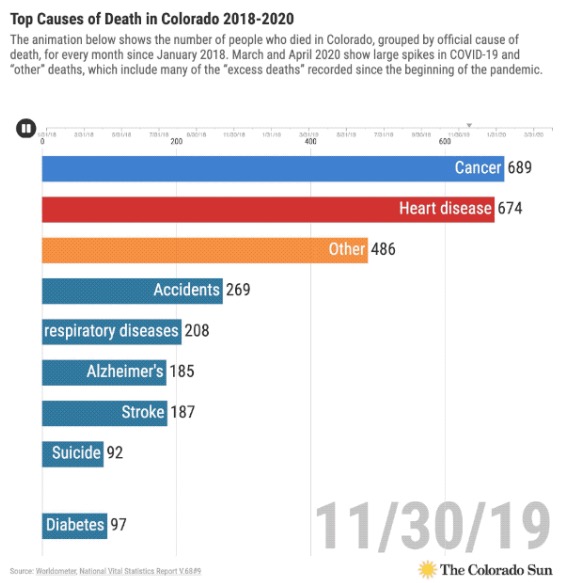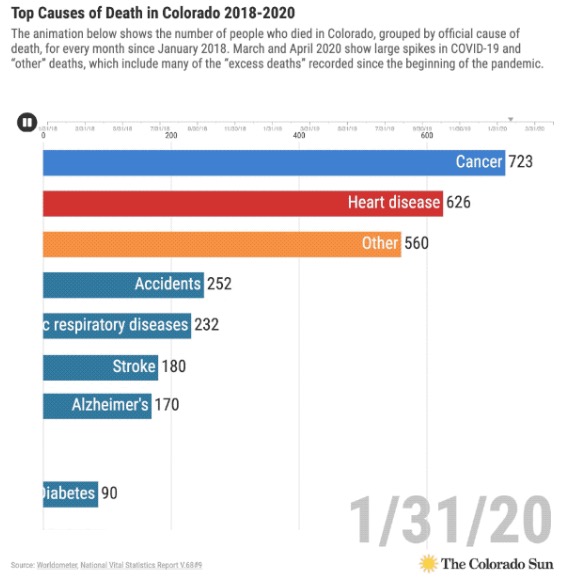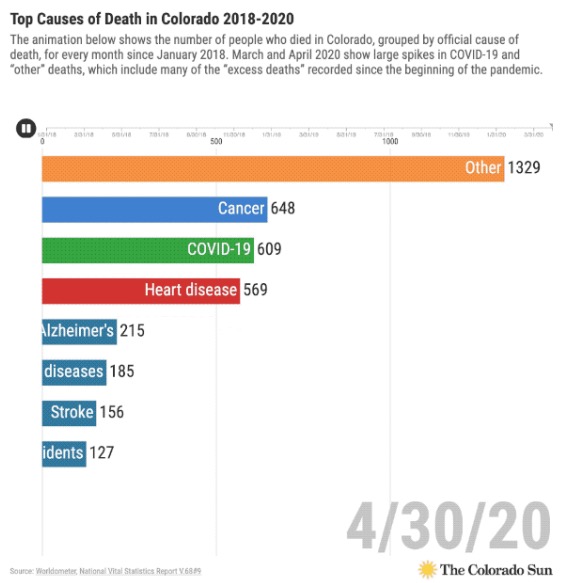In honor of Memorial Day, I’d like to begin an exploration of a timely topic.
Death, and honoring the dead.
Reporter John Ingold, one of the regular writers for the popular online media outlet, the Colorado Sun, offered a fascinating proposition last week in an article titled:
“Colorado likely won’t have an accurate coronavirus death count for months, or even years”
Reading the article, it’s easy to surmise that we may never have an accurate count… ever. Colorado’s ’cause of death’ statistics — which previously seemed to have a handle on the pulse, or rather, on the lack of a pulse — have seemingly gone haywire during this pandemic.
This topic — the ’causes of death’ — doesn’t typically get a lot of attention among the general public, until a global pandemic arrives along with a newly identified virus. Suddenly, everyone is interested in how many people are dying of what cause. How serious, really, is this alleged pandemic? Serious enough to shut down a nation’s economy for months at a time?
We’ve been tracking ’cause of death’ statistics here in the US since at least 1900, according to the National Center for Health Statistics (NCHS), although there’s no way to really know how accurate the data has been since 1900 — or how accurate it is in 2020. Typically, the cause of death is determined by a coroner or an attending physician — by a person, that is, who may not have had extensive training in diagnosing root causes of death.
For example. The Archuleta County Coroner is elected by the county’s voters, based upon political popularity. Our current County Coroner is Brandon Bishop, whose previous experience was as a Sheriff’s deputy. Can Mr. Bishop tell the difference between a death caused by pneumonia and a death caused by chronic lower respiratory disease? Maybe, maybe not.
I mention pneumonia and chronic respiratory disease, because those are two of the ‘leading causes of death’ as tracked by NCHS. The 15 ‘leading causes’ in the US for 2017 — the most recent year published — include:
- Heart disease (647,457 deaths)
- Cancer (599,108)
- Accidents (169,936)
- Chronic lower respiratory diseases (160,201)
- Stroke (146,383)
- Alzheimer’s disease (121,404)
- Diabetes (83,564)
- Influenza & pneumonia (55,627)
- Kidney disease (50,633)
- Suicide (47,173)
- Chronic liver disease (41,743)
- Septicemia (40,922)
- Hypertension (35,316)
- Parkinson’s disease (31,963)
- Inflammation of the lungs (20,108)
NCHS also includes another category. “All other causes (residual)”. In 2017, “All other causes” amounted to 561,920 deaths — nearly as many deaths as were caused by “Cancer”. NCHS does not define the meaning of “All other causes (residual)” in their report. We might presume this category includes a number of deaths caused by “We have no fricking idea what.”
Especially, we might wonder if “All other causes” could include mysterious deaths that might have been related, in the spring of 2020, to the SARS-CoV-2 virus.
In his May 21 Colorado Sun article, Mr. Ingold included a animated graphic that suggests exactly that. I’ve borrowed a few screen shots from the animation to give a sense of what’s going on. Here’s the month of July, 2019, in Colorado:
The above graphic illustrates leading causes of death in the middle of summer last year, when the Colorado economy is humming along like a well-oiled machine. Tourists from across the country and around the world are flocking here to enjoy the fabulous scenery, the recreational opportunities, the quaint historic mining towns, and who knows what else. People are traveling the highways, and the rate of deaths from accidents is reasonably high, but cancer holds firmly onto First Place, as it normally does. (Heart disease sometimes jumps into first place during the late winter, for some reason.)
We will notice, as the months go by, that “Other” causes of death, consistently holds the third place spot. Until it doesn’t.
In September, 2019, Colorado’s overall death rate is slightly higher than in July, but the causes of death have stayed pretty much the same.
Fast forward to the end of November, 2019, below, as winter is starting to set in. Another month when causes of death remain pretty much the same.
We arrive next at the end of January 2020 in Colorado, below. Cancer deaths are slightly higher, as are “Other” causes. Alzheimer’s is down slightly, and suicides have temporarily dropped off the chart.
By January’s end, the folks tracking Colorado death statistics were well aware of the SARS-CoV-2 virus… and the related illness, COVID-19, which appeared to be mainly a respiratory ailment in and around the Chinese city of Wuhan. The first confirmed US case had been reported in mid-January, but it’s possible the virus was already making its way through the US under the cover of a ‘Chronic lower respiratory disease’ diagnosis, or perhaps misdiagnosed as ‘Influenza & pneumonia’.
This next chart shows the statistical outcomes at the end of April, 2020. The Colorado picture has now changed significantly… and here’s where a mystery starts to make its appearance.
A new disease, COVID-19, has appeared in the statistical records, and has passed up heart disease as a reported cause of death. But something else equally dramatic has happened. The category of “Other” causes — deaths not easily classified — are now double the deaths caused by cancer, COVID-19, or heart disease.
Accidents have fallen to half their more typical numbers. Chronic lower respiratory diseases have fallen slightly, as have deaths due to Alzheimer’s. Suicide doesn’t appear on the chart as a leading cause of death in Colorado; nor does diabetes.
But what the heck is going on with the “Other” category? A jump from 560 in January to 1,329 in April?
Is there some statistical confusion going on?





